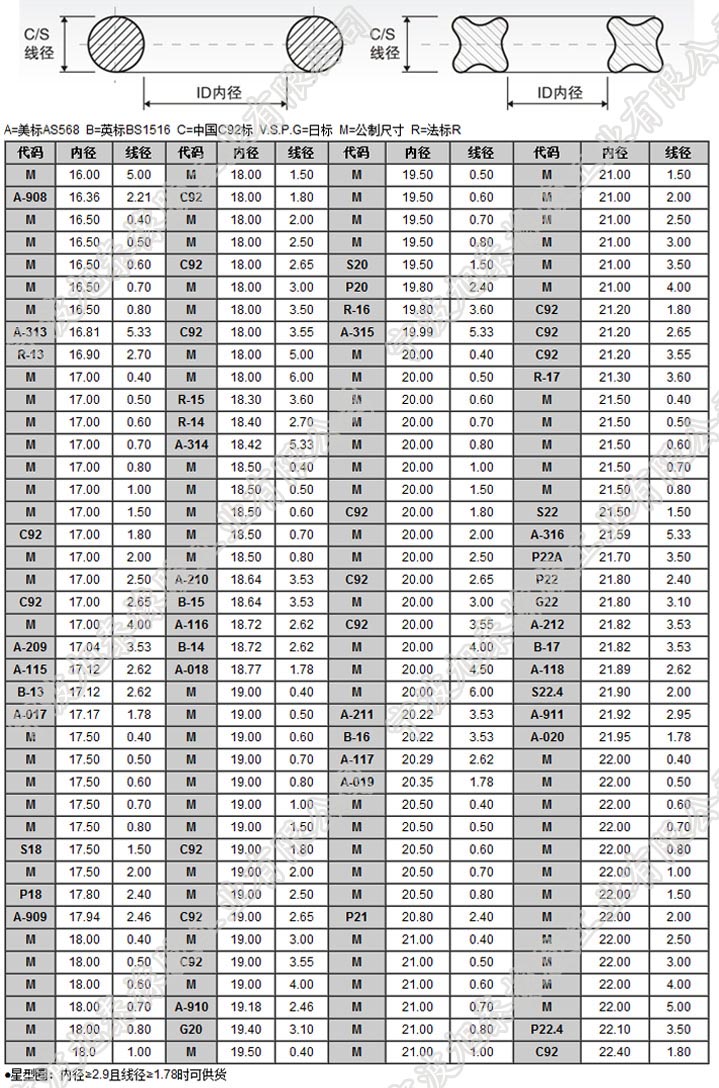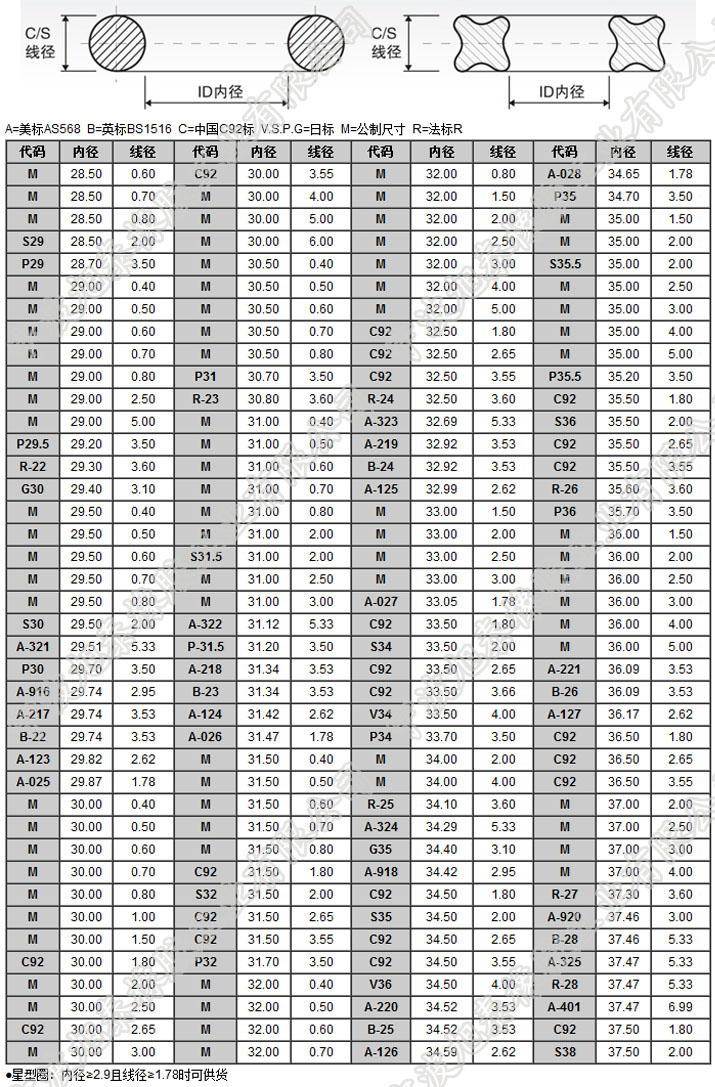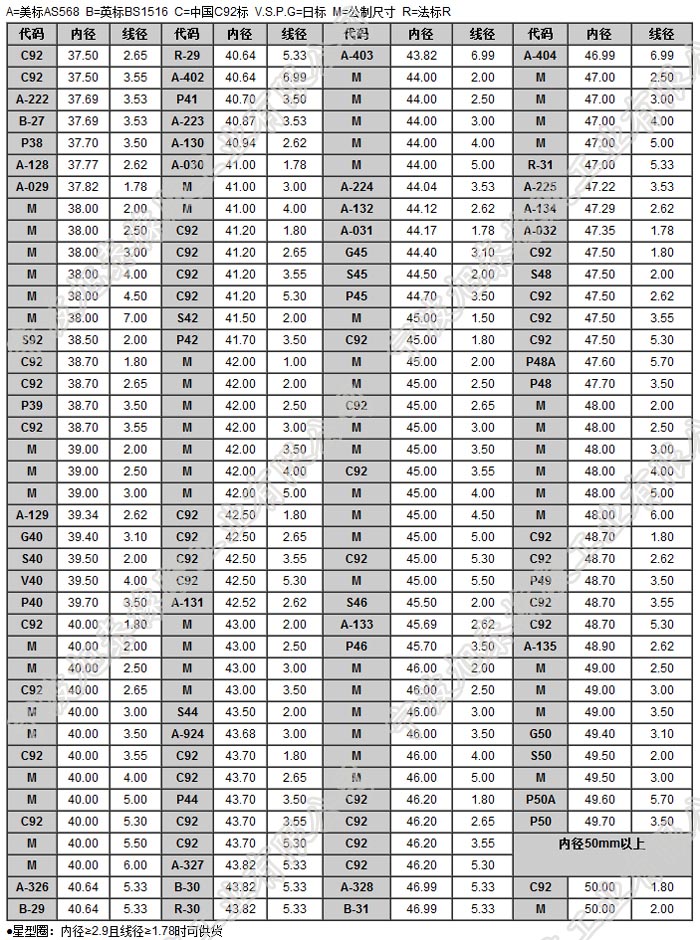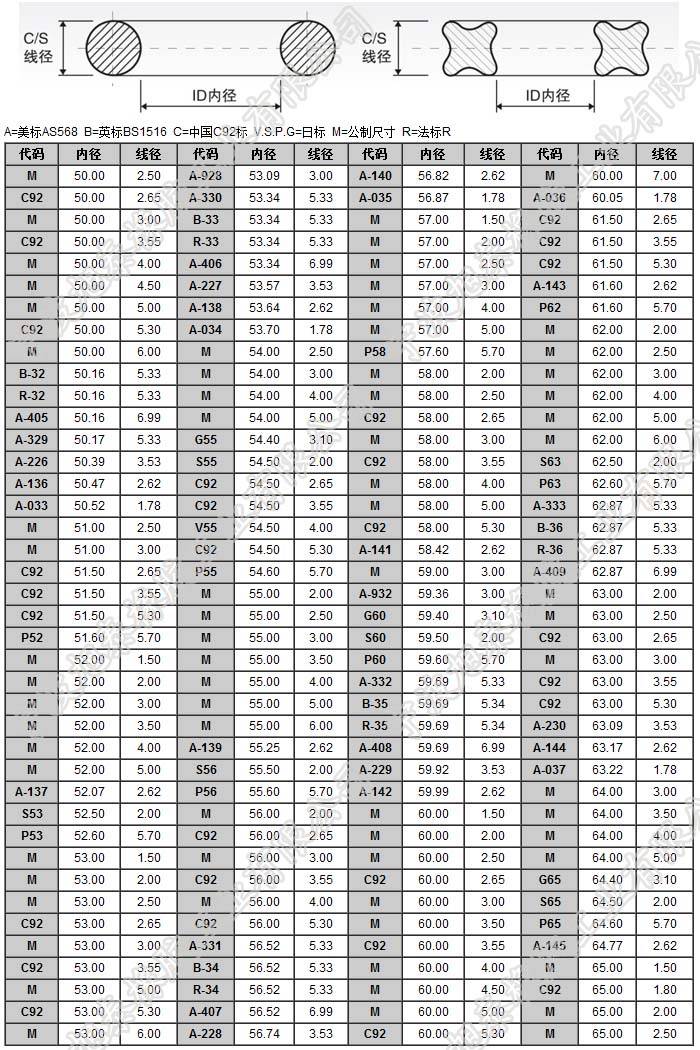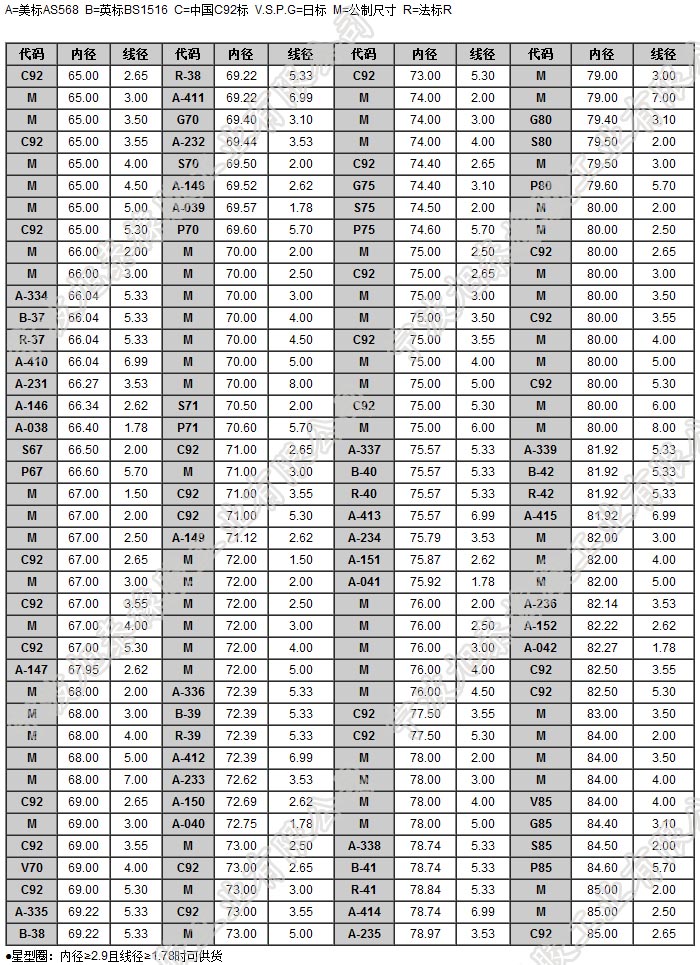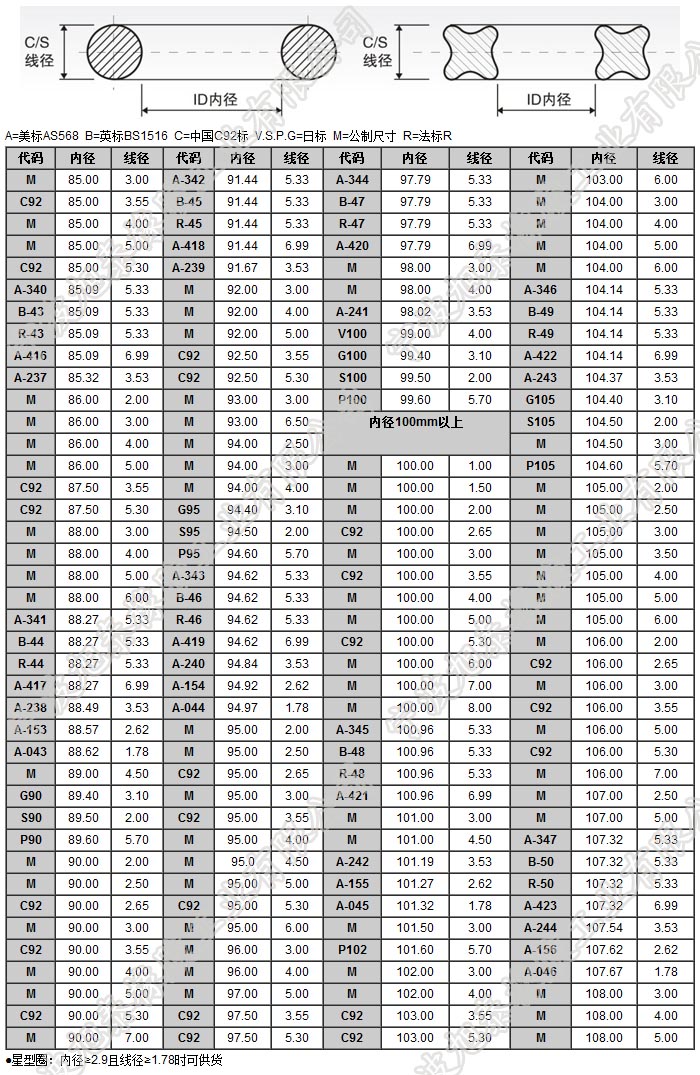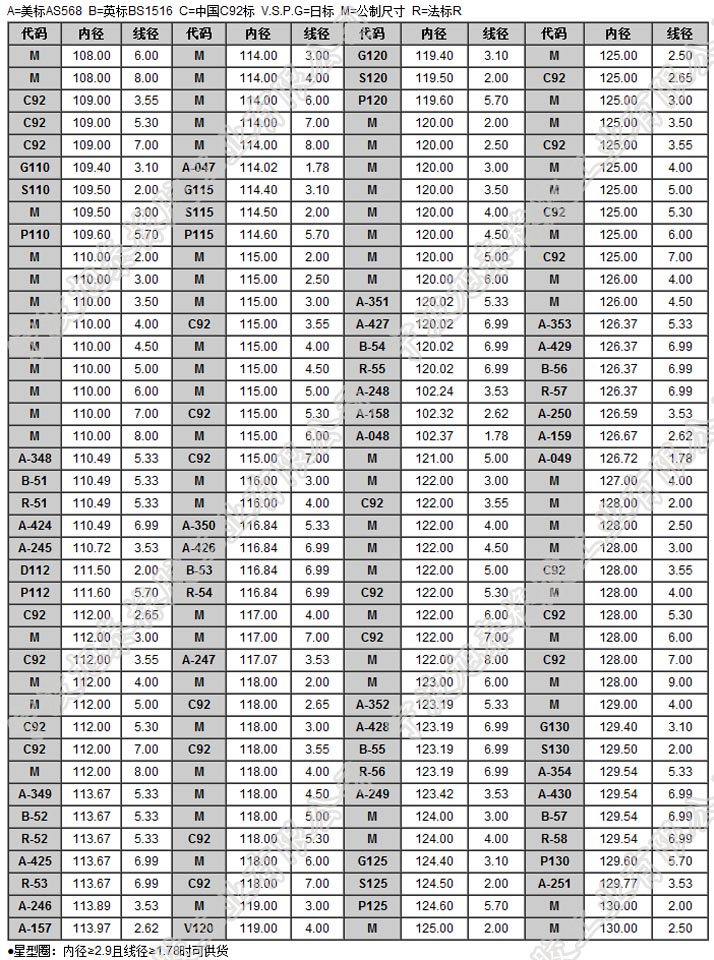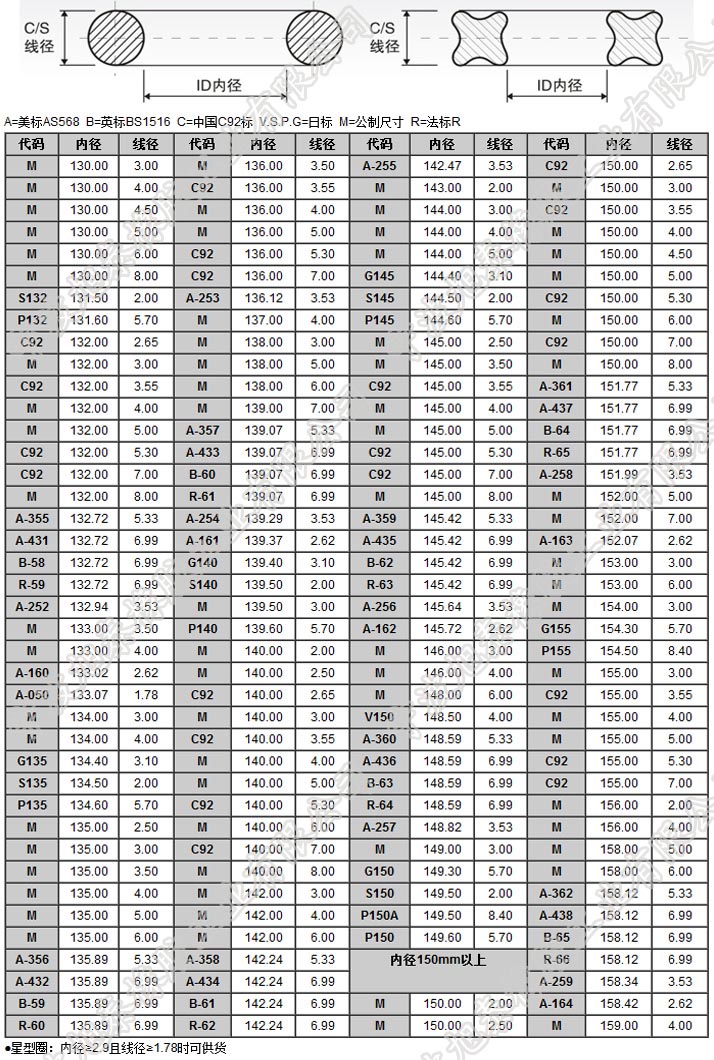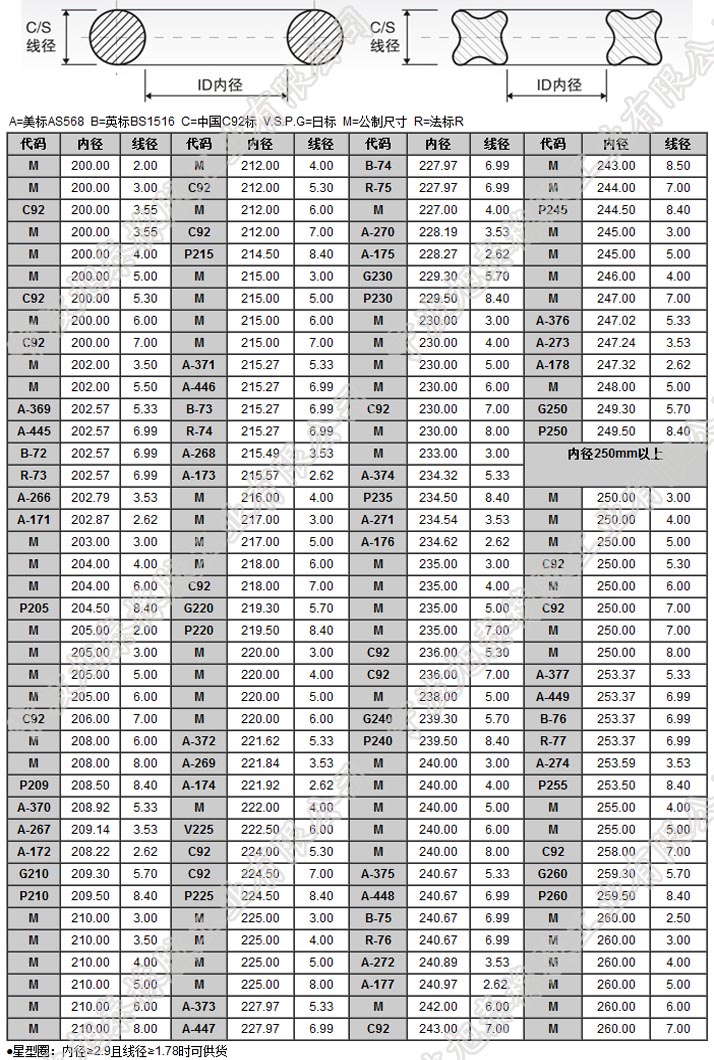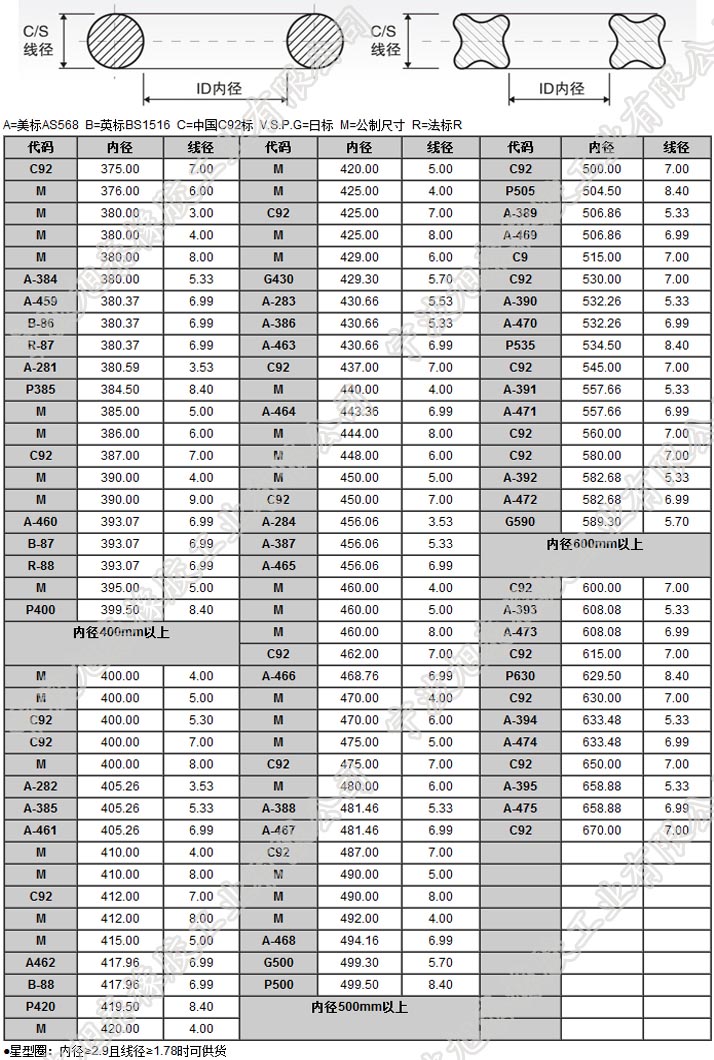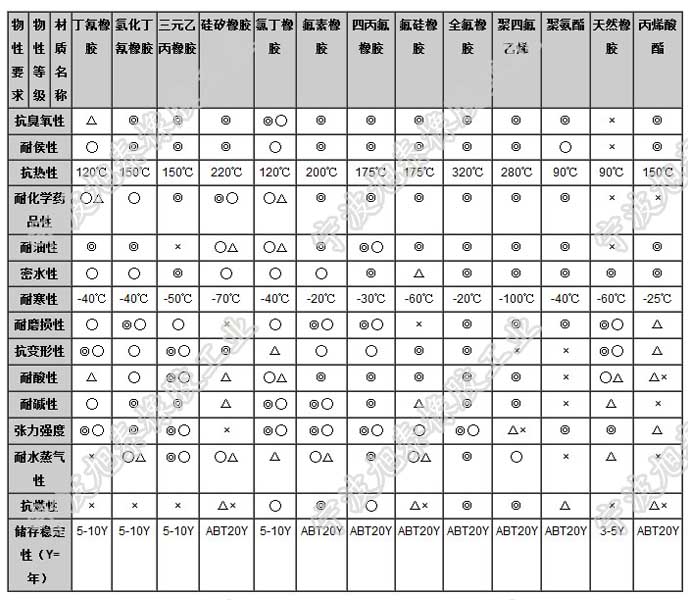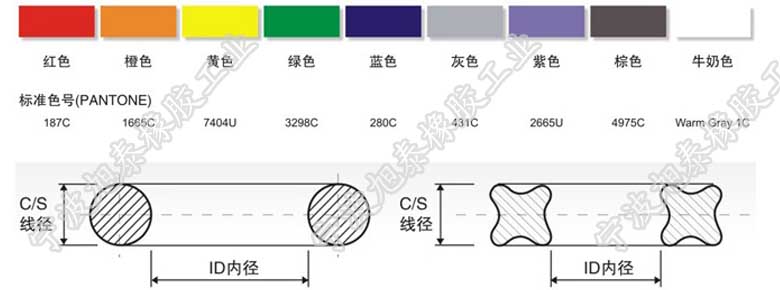The X-ring seal has excellent sealing performance and high working life. The working life of dynamic pressure sealing is 5-10 times higher than that of conventional rubber sealing products, and it can be up to tens of times. Under certain conditions, it can have the same life as the sealing base.
Pagination
X-shaped ring has low frictional resistance and equal dynamic and static frictional forces, which is 1 / 2-1 / 4 of the frictional force of "0" shaped rubber ring, which can eliminate the phenomenon of "creeping" at low speed and low pressure.
X-rings are highly wear-resistant, and have automatic elastic compensation after the sealing surface is worn.
X-ring has good self-lubricating properties. It can be used for oil-free lubrication sealing.
X-shaped ring is simple in structure and easy to install.
X-ring working pressure: 0-300MPa; working speed: ≤15m / s; working temperature: -55-250 degrees.
X-ring applicable medium: hydraulic oil, gas, water, mud, crude oil, emulsion, water-glycol, acid.
X-shaped sealing ring is suitable for installation on various mechanical equipment, under the specified temperature, pressure, and different liquid and gas medium, it plays a sealing role in static or moving state. In machine tools, ships, automobiles, aerospace equipment, metallurgical machinery, chemical machinery, engineering machinery, construction machinery, mining machinery, petroleum machinery, plastic machinery, agricultural machinery, and various types of instruments, various types of seals are widely used element. X-shaped sealing ring is mainly used for static sealing and reciprocating sealing. When used for rotary motion sealing, it is limited to low-speed rotary sealing devices. X-shaped seals are generally installed in grooves with a rectangular cross-section on the outer or inner circle for sealing. The X-shaped seal ring still plays a good role in sealing and damping in the environment of oil resistance, acid and alkali, grinding, chemical corrosion and other environments. Therefore, the X-ring is the most widely used seal in hydraulic and pneumatic transmission systems.
Compared with other types of sealing ring, X-shaped sealing ring has the following advantages:
--Suitable for multiple sealing forms: static sealing, dynamic sealing
--Suitable for all kinds of materials, the size and groove have been standardized, and the interchangeability is strong
--Suitable for a variety of movement methods: rotary movement, axial reciprocating movement or combined movement (such as rotary reciprocating combined movement)
--Suitable for many different sealing media: oil, water, gas, chemical media or other mixed media
--Through the selection of appropriate rubber materials and appropriate formula design, to achieve an effective sealing effect on oil, water, air, gas and various chemical media. The temperature can be used in a wide range (-60 ℃ ~ + 220 ℃), and the pressure can reach 1500Kg / cm2 in fixed use (combined with reinforcement ring).
--Simple design, compact structure, convenient assembly and disassembly
X-shaped ring cross-section structure is extremely simple, and has a self-sealing effect, reliable sealing performance.
Since the structure of the X-ring itself and the installation site are extremely simple and standardized, it is very easy to install and replace.
--Various varieties of materials
Can be selected according to different fluids: nitrile rubber (NBR), fluorine rubber (FKM), silicone rubber (VMQ), ethylene propylene rubber (EPDM), neoprene rubber (CR), butyl rubber (BU), polymer Tetrafluoroethylene (PTFE), natural rubber (NR), etc.
--low cost
--The dynamic friction resistance is relatively small
X-ring material classification comparison and advantages and disadvantages:
1. Natural rubber NR
(Natural Rubber) is made from latex collected from rubber trees and is a polymer of isoprene. Has good wear resistance, high elasticity, tear strength and elongation. It is easy to age in the air, becomes sticky when heated, easily expands and dissolves in mineral oil or gasoline, and is resistant to alkali but not strong acid. · It is the raw material for making adhesive tape, hose, rubber shoes, and is suitable for making shock-absorbing parts, and products used in hydroxide-containing liquids such as automobile brake fluid and ethanol.
2. Styrene butadiene rubber S B R
(Styrene Butadiene CXpXlyme) Butadiene and styrene copolymer, compared with natural rubber, uniform quality, less foreign matter, but the mechanical strength is weaker, can be blended with natural rubber.
Advantages:
--Low cost, non-oil resistant material
--Good water resistance, good elasticity below hardness 70
--Poor compression distortion at high hardness
--Most neutral chemical substances and dry and nourishing organic ketones can be used
Disadvantages:
It is not recommended to use strong acids, ozone, oils, oil esters and fats and most hydrocarbons. · Widely used in tire industry, shoe industry, cloth industry and conveyor belt industry, etc.
3. Butyl rubber IIR
(Butyl Rubber) is formed by the polymerization of isobutylene with a small amount of isXprenes, which retains a small amount of unsaturated groups for sulfuration. Because the movement of steric obstacle molecules of methyl group is less than other polymers, the gas permeability is less, and The resistance to sunlight and ozone is large, and the electrical insulation is good; it is resistant to polar solvents such as alcohol, ketone, and ester, and the general temperature range is -54 ~ 110 ℃.
Advantages:
--It is impermeable to most general gases
--Good resistance to sunlight and ozone
--Can be exposed to animal or vegetable oils or oxidizable chemicals
Disadvantages:
--Do not use it together with petroleum solvents, kerosene and aromatic hydrogen.
--For the production of rubber parts that are resistant to chemicals and vacuum equipment.
4. Hydrogenated NBR HNBR
(HydrXgenate Nitrile) Hydrogenated nitrile butadiene rubber is a part of double-stranded chain which is removed by hydrogenation in nitrile rubber. After hydrogenation, its temperature resistance and weather resistance are much improved compared with ordinary nitrile rubber, and its oil resistance is similar to that of nitrile rubber. The general use temperature range is -25 ~ 150 ℃.
Advantages:
--It has better abrasion resistance than nitrile gel
--Excellent corrosion resistance, tensile resistance, tear resistance and compression distortion characteristics
--Good resistance to ozone, sunlight and other atmospheric conditions
--Generally suitable for cleaning agents for washing or washing dishes
Disadvantages:
--Not recommended for use in alcohols, esters or aromatic solutions.
--Air conditioning and refrigeration industry, widely used as seals in environmentally friendly refrigerant R134a system.
--Auto engine seals.
5. EPDM EPDM
(Ethylene prXpylene Rubber) is composed of ethylene and propylene copolymerized into a main chain without double-strands. Therefore, heat resistance, aging resistance, ozone resistance, and stability are all excellent, but sulfur cannot be added. In order to solve this problem, a small amount of double-chain third component is introduced into the EP main chain and sulfur can be added by sulfur to form EPDM. The general temperature range is -50 ~ 150 ℃. Excellent resistance to polar solvents such as alcohols, ketones, glycols and phosphate esters.
Advantages:
--Good weather resistance and ozone resistance
--Excellent water resistance and chemical resistance
--Alcohols and ketones can be used
--High temperature steam resistance, good impermeability to gas
Disadvantages:
--Not recommended for food use or exposure to aromatic hydrogen.
--Seal for high temperature water vapor environment.
--Sanitary equipment seals or parts.
--Brake (brake) rubber parts in the system.
--The seal in the radiator (car water tank).
6. Nitrile NBR
(Nitrile Rubber) It is made by copolymerization of acrylonitrile and butadiene. The content of acrylonitrile is from 18% to 50%. The higher the content of acrylonitrile, the better the resistance to petrochemical oil hydrocarbon fuel oil, but the low temperature performance Deterioration, the general operating temperature range is -25 ~ 100 ℃. Nitrile is one of the most commonly used rubbers for oil seals and X-rings.
Advantages:
--With good resistance to oil, water, solvent and high pressure oil.
--With good compression distortion, anti-wear and elongation.
Disadvantages:
--Not suitable for polar solvents, such as ketones, ozone, nitro hydrocarbons, MEK and chloroform.
-Used to make fuel tanks, lubricating oil tanks and rubber parts used in fluid media such as petroleum-based hydraulic oil, gasoline, water, silicon grease, silicone oil, diester-based lubricants, glycol-based hydraulic oil, etc. Components. It can be said that it is the most widely used and lowest cost rubber seal.
7. Neoprene CR
(NeXprene, PXlychlXrXprene) is made by polymerizing chloroprene monomer. The vulcanized rubber has good abrasion resistance, is not afraid of direct sunlight, has particularly good atmospheric aging resistance, is not afraid of fierce distortion, is not afraid of refrigerants such as dichlorodifluoromethane and ammonia, and is resistant to dilute acids and silicon ester Lubricating oil, but not resistant to phosphate ester hydraulic oil. It is easy to crystallize and harden at low temperature, has poor storage stability, and has a large amount of expansion in mineral oil with a low aniline point. The general use temperature range is -50 ~ 150 ℃
Advantages:
--Good elasticity and good compression deformation.
--The formula does not contain sulfur, so it is very easy to make
--With anti-animal and vegetable oil properties
--It will not affect the physical properties due to neutral chemicals, fats, oils, various oils and solvents
--With anti-flammability characteristics
Disadvantages:
--It is not recommended to use strong acids, nitro hydrocarbons, esters, chloroform and ketones.
--R12 refrigerant-resistant seals.
--Rubber parts or seals on your home appliances.
--Suitable for making all kinds of parts directly exposed to the atmosphere, sunlight and ozone.
--Applicable to all kinds of rubber products that are resistant to fire and chemical corrosion.
8. Chlorosulfonated polyethylene adhesive CSM
(HypalXn, PXlyethylene) Chlorosulfonated polyethylene is DuPont's patented synthetic rubber. Good heat resistance, weather resistance, ozone resistance; good acid resistance, commonly used in oxidation-resistant chemicals (nitric acid, sulfuric acid), the general use temperature range is -45 ~ 120 ℃.
Advantages:
--Good resistance to ozone, oxidation and flame
--Physical properties are similar to neoprene and have better acid resistance
--Excellent abrasion resistance
--Has the same low friction surface as nitrile gel
--The resistance to oil and solvent is between nitrile rubber and neoprene
--It is recommended to use water to prevent leakage
Disadvantages:
--It is not recommended to be exposed to concentrated oxidizing acids, nitro hydrocarbons, esters, ketones and fragrant hydrogen.
9. Silicone rubber SI
(SilicXne Rubber) The main chain of silica gel is composed of silicon (-si-X-si). It has excellent heat resistance, cold resistance, ozone resistance and atmospheric aging resistance. Has good electrical insulation properties. The tensile strength is inferior to ordinary rubber and has no oil resistance. advantage:
--After being formulated, the tensile strength can reach 1500PSI and the tear resistance can reach 88LBS
--Good elasticity and good compressibility
--Good resistance to neutral solvents
--Excellent heat resistance
--Excellent cold resistance
--Excellent resistance to ozone and oxide erosion
--Excellent electrical insulation performance
--Excellent heat insulation and heat dissipation
Disadvantages:
--Not recommended for use in most concentrated solvents, oils, concentrated acids and diluted sodium hydroxide.
--Seals or rubber parts used in the household appliance industry, such as rubber parts in electric kettles, irons, and microwave ovens.
--Seals or rubber parts in the electronics industry, such as mobile phone keys, shock-absorbing pads in DVDs, seals in cable connectors, etc.
--Seals on various supplies that have contact with the human body, such as kettles, water dispensers, etc.
10. Silicone Fluorine Rubber FLS
(FluXrinated SilicXne Rubber) Silicone fluororubber is fluorinated silicone rubber, its general performance has the advantages of fluororubber and silicone rubber; its oil resistance, solvent resistance, fuel oil resistance and high and low temperature resistance are good, the general use temperature It is -50 ~ 200 ℃.
Advantages:
--Suitable for special purposes, such as the requirement to resist the corrosion of oxygen-containing chemicals, aromatic hydrogen-containing solvents and chlorine-containing solvents.
Disadvantages:
--Not recommended for exposure to brake fluids, ketones and hydrazine solutions
--On the space machine.
11. Fluorine rubber FPM
(FluXrX CarbXn Rubber) There are various types of fluorine-containing rubber in the molecule, depending on the fluorine content (that is, the monomer structure). At present, the widely used hexafluoride fluoroelastomer was first marketed by DuPont under the trade name "VitXn". High temperature resistance is better than silicone rubber, has excellent chemical resistance, resistance to most oils and solvents (except ketones, esters), weather resistance and ozone resistance; cold resistance is poor, the general use temperature range is -20 ~ 250 ℃. Special formula can resist low temperature to -40 ℃.
Advantages:
--Can resist heat to 250 ℃
--Resistant to most oils and solvents, especially all acids, aliphatic hydrocarbons, aromatic hydrocarbons, animal and vegetable oils
Disadvantages:
--Not recommended for ketones, low molecular weight esters and nitrate-containing mixtures.
--Automobiles, locomotives, diesel engines and fuel systems.
--Seal for chemical plant.
12. Perfluoroelastomer FFPM (PerfluXrXelastXmer)
Advantages:
--The best heat resistance
--Excellent chemical resistance
--Low Xutgassing characteristics
--Excellent anti-Plasma properties
Disadvantages:
--Poor low temperature resistance
--High raw material prices
--High production difficulty
--Perfluorinated products are widely used in the semiconductor industry and information-related industries. The scope of application includes PVC, CVD and etching processes in thin film processes and various high vacuum sealing processes.
13. Acrylate rubber ACM
(PXlyacrylate Rubber) An elastomer composed of Alkyl Ester Acrylate as the main component. It is resistant to petrochemical oil, high temperature, and weather. It is weaker in mechanical strength, compression deformation rate, and water resistance. difference. The general operating temperature range is -25 ~ 170 ℃.
Advantages:
--Suitable for automobile transmission oil
--With good oxidation resistance and weather resistance
--With the function of anti-bending deformation
--Excellent resistance to oil
--Applicable to steam
~The X-ring seal has excellent sealing performance and high working life. The working life of dynamic pressure sealing is 5-10 times higher than that of conventional rubber sealing products, and it can be up to tens of times. Under certain conditions, it can have the same life as the sealing base.
Pagination
X-shaped ring has low frictional resistance and equal dynamic and static frictional forces, which is 1 / 2-1 / 4 of the frictional force of "0" shaped rubber ring, which can eliminate the phenomenon of "creeping" at low speed and low pressure.
X-rings are highly wear-resistant, and have automatic elastic compensation after the sealing surface is worn.
X-ring has good self-lubricating properties. It can be used for oil-free lubrication sealing.
X-shaped ring is simple in structure and easy to install.
X-ring working pressure: 0-300MPa; working speed: ≤15m / s; working temperature: -55-250 degrees.
X-ring applicable medium: hydraulic oil, gas, water, mud, crude oil, emulsion, water-glycol, acid.
X-shaped sealing ring is suitable for installation on various mechanical equipment, under the specified temperature, pressure, and different liquid and gas medium, it plays a sealing role in static or moving state. In machine tools, ships, automobiles, aerospace equipment, metallurgical machinery, chemical machinery, engineering machinery, construction machinery, mining machinery, petroleum machinery, plastic machinery, agricultural machinery, and various types of instruments, various types of seals are widely used element. X-shaped sealing ring is mainly used for static sealing and reciprocating sealing. When used for rotary motion sealing, it is limited to low-speed rotary sealing devices. X-shaped seals are generally installed in grooves with a rectangular cross-section on the outer or inner circle for sealing. The X-shaped seal ring still plays a good role in sealing and damping in the environment of oil resistance, acid and alkali, grinding, chemical corrosion and other environments. Therefore, the X-ring is the most widely used seal in hydraulic and pneumatic transmission systems.
Compared with other types of sealing ring, X-shaped sealing ring has the following advantages:
--Suitable for multiple sealing forms: static sealing, dynamic sealing
--Suitable for all kinds of materials, the size and groove have been standardized, and the interchangeability is strong
--Suitable for a variety of movement methods: rotary movement, axial reciprocating movement or combined movement (such as rotary reciprocating combined movement)
--Suitable for many different sealing media: oil, water, gas, chemical media or other mixed media
--Through the selection of appropriate rubber materials and appropriate formula design, to achieve an effective sealing effect on oil, water, air, gas and various chemical media. The temperature can be used in a wide range (-60 ℃ ~ + 220 ℃), and the pressure can reach 1500Kg / cm2 in fixed use (combined with reinforcement ring).
--Simple design, compact structure, convenient assembly and disassembly
X-shaped ring cross-section structure is extremely simple, and has a self-sealing effect, reliable sealing performance.
Since the structure of the X-ring itself and the installation site are extremely simple and standardized, it is very easy to install and replace.
--Various varieties of materials
Can be selected according to different fluids: nitrile rubber (NBR), fluorine rubber (FKM), silicone rubber (VMQ), ethylene propylene rubber (EPDM), neoprene rubber (CR), butyl rubber (BU), polymer Tetrafluoroethylene (PTFE), natural rubber (NR), etc.
--low cost
--The dynamic friction resistance is relatively small
X-ring material classification comparison and advantages and disadvantages:
1. Natural rubber NR
(Natural Rubber) is made from latex collected from rubber trees and is a polymer of isoprene. Has good wear resistance, high elasticity, tear strength and elongation. It is easy to age in the air, becomes sticky when heated, easily expands and dissolves in mineral oil or gasoline, and is resistant to alkali but not strong acid. · It is the raw material for making adhesive tape, hose, rubber shoes, and is suitable for making shock-absorbing parts, and products used in hydroxide-containing liquids such as automobile brake fluid and ethanol.
2. Styrene butadiene rubber S B R
(Styrene Butadiene CXpXlyme) Butadiene and styrene copolymer, compared with natural rubber, uniform quality, less foreign matter, but the mechanical strength is weaker, can be blended with natural rubber.
Advantages:
--Low cost, non-oil resistant material
--Good water resistance, good elasticity below hardness 70
--Poor compression distortion at high hardness
--Most neutral chemical substances and dry and nourishing organic ketones can be used
Disadvantages:
It is not recommended to use strong acids, ozone, oils, oil esters and fats and most hydrocarbons. · Widely used in tire industry, shoe industry, cloth industry and conveyor belt industry, etc.
3. Butyl rubber IIR
(Butyl Rubber) is formed by the polymerization of isobutylene with a small amount of isXprenes, which retains a small amount of unsaturated groups for sulfuration. Because the movement of steric obstacle molecules of methyl group is less than other polymers, the gas permeability is less, and The resistance to sunlight and ozone is large, and the electrical insulation is good; it is resistant to polar solvents such as alcohol, ketone, and ester, and the general temperature range is -54 ~ 110 ℃.
Advantages:
--It is impermeable to most general gases
--Good resistance to sunlight and ozone
--Can be exposed to animal or vegetable oils or oxidizable chemicals
Disadvantages:
--Do not use it together with petroleum solvents, kerosene and aromatic hydrogen.
--For the production of rubber parts that are resistant to chemicals and vacuum equipment.
4. Hydrogenated NBR HNBR
(HydrXgenate Nitrile) Hydrogenated nitrile butadiene rubber is a part of double-stranded chain which is removed by hydrogenation in nitrile rubber. After hydrogenation, its temperature resistance and weather resistance are much improved compared with ordinary nitrile rubber, and its oil resistance is similar to that of nitrile rubber. The general use temperature range is -25 ~ 150 ℃.
Advantages:
--It has better abrasion resistance than nitrile gel
--Excellent corrosion resistance, tensile resistance, tear resistance and compression distortion characteristics
--Good resistance to ozone, sunlight and other atmospheric conditions
--Generally suitable for cleaning agents for washing or washing dishes
Disadvantages:
--Not recommended for use in alcohols, esters or aromatic solutions.
--Air conditioning and refrigeration industry, widely used as seals in environmentally friendly refrigerant R134a system.
--Auto engine seals.
5. EPDM EPDM
(Ethylene prXpylene Rubber) is composed of ethylene and propylene copolymerized into a main chain without double-strands. Therefore, heat resistance, aging resistance, ozone resistance, and stability are all excellent, but sulfur cannot be added. In order to solve this problem, a small amount of double-chain third component is introduced into the EP main chain and sulfur can be added by sulfur to form EPDM. The general temperature range is -50 ~ 150 ℃. Excellent resistance to polar solvents such as alcohols, ketones, glycols and phosphate esters.
Advantages:
--Good weather resistance and ozone resistance
--Excellent water resistance and chemical resistance
--Alcohols and ketones can be used
--High temperature steam resistance, good impermeability to gas
Disadvantages:
--Not recommended for food use or exposure to aromatic hydrogen.
--Seal for high temperature water vapor environment.
--Sanitary equipment seals or parts.
--Brake (brake) rubber parts in the system.
--The seal in the radiator (car water tank).
6. Nitrile NBR
(Nitrile Rubber) It is made by copolymerization of acrylonitrile and butadiene. The content of acrylonitrile is from 18% to 50%. The higher the content of acrylonitrile, the better the resistance to petrochemical oil hydrocarbon fuel oil, but the low temperature performance Deterioration, the general operating temperature range is -25 ~ 100 ℃. Nitrile is one of the most commonly used rubbers for oil seals and X-rings.
Advantages:
--With good resistance to oil, water, solvent and high pressure oil.
--With good compression distortion, anti-wear and elongation.
Disadvantages:
--Not suitable for polar solvents, such as ketones, ozone, nitro hydrocarbons, MEK and chloroform.
-Used to make fuel tanks, lubricating oil tanks and rubber parts used in fluid media such as petroleum-based hydraulic oil, gasoline, water, silicon grease, silicone oil, diester-based lubricants, glycol-based hydraulic oil, etc. Components. It can be said that it is the most widely used and lowest cost rubber seal.
7. Neoprene CR
(NeXprene, PXlychlXrXprene) is made by polymerizing chloroprene monomer. The vulcanized rubber has good abrasion resistance, is not afraid of direct sunlight, has particularly good atmospheric aging resistance, is not afraid of fierce distortion, is not afraid of refrigerants such as dichlorodifluoromethane and ammonia, and is resistant to dilute acids and silicon ester Lubricating oil, but not resistant to phosphate ester hydraulic oil. It is easy to crystallize and harden at low temperature, has poor storage stability, and has a large amount of expansion in mineral oil with a low aniline point. The general use temperature range is -50 ~ 150 ℃
Advantages:
--Good elasticity and good compression deformation.
--The formula does not contain sulfur, so it is very easy to make
--With anti-animal and vegetable oil properties
--It will not affect the physical properties due to neutral chemicals, fats, oils, various oils and solvents
--With anti-flammability characteristics
Disadvantages:
--It is not recommended to use strong acids, nitro hydrocarbons, esters, chloroform and ketones.
--R12 refrigerant-resistant seals.
--Rubber parts or seals on your home appliances.
--Suitable for making all kinds of parts directly exposed to the atmosphere, sunlight and ozone.
--Applicable to all kinds of rubber products that are resistant to fire and chemical corrosion.
8. Chlorosulfonated polyethylene adhesive CSM
(HypalXn, PXlyethylene) Chlorosulfonated polyethylene is DuPont's patented synthetic rubber. Good heat resistance, weather resistance, ozone resistance; good acid resistance, commonly used in oxidation-resistant chemicals (nitric acid, sulfuric acid), the general use temperature range is -45 ~ 120 ℃.
Advantages:
--Good resistance to ozone, oxidation and flame
--Physical properties are similar to neoprene and have better acid resistance
--Excellent abrasion resistance
--Has the same low friction surface as nitrile gel
--The resistance to oil and solvent is between nitrile rubber and neoprene
--It is recommended to use water to prevent leakage
Disadvantages:
--It is not recommended to be exposed to concentrated oxidizing acids, nitro hydrocarbons, esters, ketones and fragrant hydrogen.
9. Silicone rubber SI
(SilicXne Rubber) The main chain of silica gel is composed of silicon (-si-X-si). It has excellent heat resistance, cold resistance, ozone resistance and atmospheric aging resistance. Has good electrical insulation properties. The tensile strength is inferior to ordinary rubber and has no oil resistance. advantage:
--After being formulated, the tensile strength can reach 1500PSI and the tear resistance can reach 88LBS
--Good elasticity and good compressibility
--Good resistance to neutral solvents
--Excellent heat resistance
--Excellent cold resistance
--Excellent resistance to ozone and oxide erosion
--Excellent electrical insulation performance
--Excellent heat insulation and heat dissipation
Disadvantages:
--Not recommended for use in most concentrated solvents, oils, concentrated acids and diluted sodium hydroxide.
--Seals or rubber parts used in the household appliance industry, such as rubber parts in electric kettles, irons, and microwave ovens.
--Seals or rubber parts in the electronics industry, such as mobile phone keys, shock-absorbing pads in DVDs, seals in cable connectors, etc.
--Seals on various supplies that have contact with the human body, such as kettles, water dispensers, etc.
10. Silicone Fluorine Rubber FLS
(FluXrinated SilicXne Rubber) Silicone fluororubber is fluorinated silicone rubber, its general performance has the advantages of fluororubber and silicone rubber; its oil resistance, solvent resistance, fuel oil resistance and high and low temperature resistance are good, the general use temperature It is -50 ~ 200 ℃.
Advantages:
--Suitable for special purposes, such as the requirement to resist the corrosion of oxygen-containing chemicals, aromatic hydrogen-containing solvents and chlorine-containing solvents.
Disadvantages:
--Not recommended for exposure to brake fluids, ketones and hydrazine solutions
--On the space machine.
11. Fluorine rubber FPM
(FluXrX CarbXn Rubber) There are various types of fluorine-containing rubber in the molecule, depending on the fluorine content (that is, the monomer structure). At present, the widely used hexafluoride fluoroelastomer was first marketed by DuPont under the trade name "VitXn". High temperature resistance is better than silicone rubber, has excellent chemical resistance, resistance to most oils and solvents (except ketones, esters), weather resistance and ozone resistance; cold resistance is poor, the general use temperature range is -20 ~ 250 ℃. Special formula can resist low temperature to -40 ℃.
Advantages:
--Can resist heat to 250 ℃
--Resistant to most oils and solvents, especially all acids, aliphatic hydrocarbons, aromatic hydrocarbons, animal and vegetable oils
Disadvantages:
--Not recommended for ketones, low molecular weight esters and nitrate-containing mixtures.
--Automobiles, locomotives, diesel engines and fuel systems.
--Seal for chemical plant.
12. Perfluoroelastomer FFPM (PerfluXrXelastXmer)
Advantages:
--The best heat resistance
--Excellent chemical resistance
--Low Xutgassing characteristics
--Excellent anti-Plasma properties
Disadvantages:
--Poor low temperature resistance
--High raw material prices
--High production difficulty
--Perfluorinated products are widely used in the semiconductor industry and information-related industries. The scope of application includes PVC, CVD and etching processes in thin film processes and various high vacuum sealing processes.
13. Acrylate rubber ACM
(PXlyacrylate Rubber) An elastomer composed of Alkyl Ester Acrylate as the main component. It is resistant to petrochemical oil, high temperature, and weather. It is weaker in mechanical strength, compression deformation rate, and water resistance. difference. The general operating temperature range is -25 ~ 170 ℃.
Advantages:
--Suitable for automobile transmission oil
--With good oxidation resistance and weather resistance
--With the function of anti-bending deformation
--Excellent resistance to oil
--Applicable to steam




